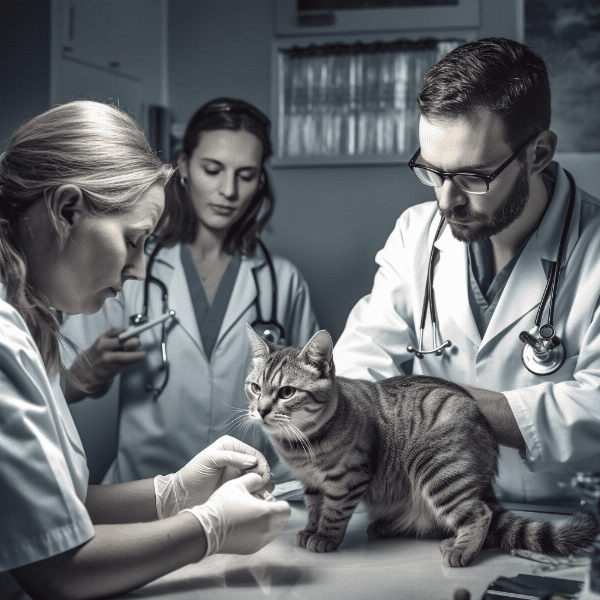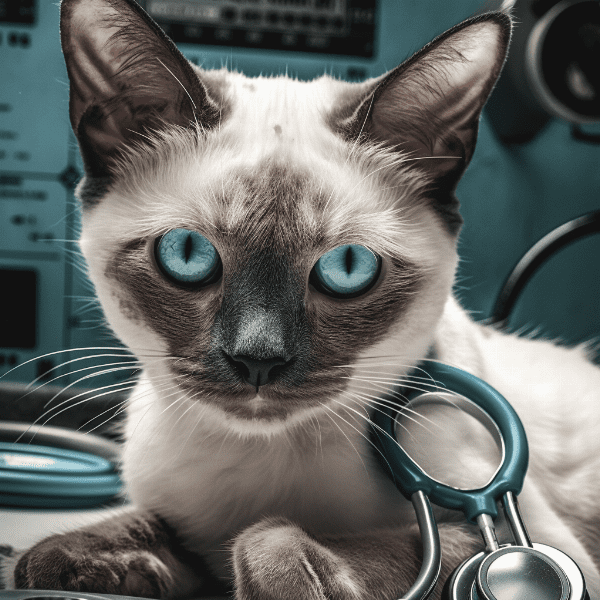Table of Contents
- Understanding Feline Oral Cancer
- Signs and Symptoms of Oral Cancer in Cats
- Diagnosis and Staging of Feline Oral Cancer
- Common Treatment Options for Feline Oral Cancer
- Surgery for Feline Oral Cancer: What to Expect
- Radiation Therapy for Feline Oral Cancer: Pros and Cons
- Chemotherapy for Feline Oral Cancer: Is it Effective?
- Managing Pain and Supporting Your Cat’s Quality of Life
Understanding Feline Oral Cancer
Feline oral cancer is a type of cancer that affects a cat’s mouth or throat. It is one of the most common types of cancer in cats and can occur in any breed or age. Feline oral cancer can affect different parts of the mouth, including the gums, tongue, and roof of the mouth.
How Feline Oral Cancer Develops
Feline oral cancer usually begins as a small, localized tumor in the mouth. Over time, the tumor can grow and spread to other parts of the body, such as the lymph nodes or lungs. The exact cause of feline oral cancer is unknown, but certain risk factors have been identified, such as exposure to secondhand smoke, poor oral hygiene, and certain viral infections.
Symptoms of Feline Oral Cancer
The symptoms of feline oral cancer can vary depending on the location and severity of the tumor. Some common signs include:
- Difficulty eating or swallowing
- Excessive drooling
- Bad breath
- Bleeding from the mouth
- Weight loss
- Swelling in the face or neck
If you notice any of these symptoms in your cat, it’s important to take them to a veterinarian as soon as possible for a diagnosis.
Types of Feline Oral Cancer
There are several types of feline oral cancer, including squamous cell carcinoma, fibrosarcoma, and melanoma. Squamous cell carcinoma is the most common type, accounting for about 70% of cases. It typically occurs on the gums or tongue and can be very aggressive.
Risk Factors for Feline Oral Cancer
While the exact cause of feline oral cancer is unknown, there are certain risk factors that can increase a cat’s likelihood of developing the disease. These include:
- Exposure to secondhand smoke
- Poor oral hygiene
- Certain viral infections
- Age (older cats are more likely to develop oral cancer)
- Breed (some breeds, such as Siamese and Abyssinians, may be more prone to oral cancer)
By understanding the risk factors for feline oral cancer, you can take steps to help prevent the disease from developing in your cat. Regular veterinary check-ups, good oral hygiene, and avoiding exposure to secondhand smoke are all important preventative measures.

Signs and Symptoms of Oral Cancer in Cats
Feline oral cancer can be difficult to detect in its early stages, as cats are notorious for hiding signs of illness. However, there are several symptoms that may indicate the presence of oral cancer in cats.
Changes in Eating Habits
One of the most common signs of oral cancer in cats is a change in eating habits. Cats with oral cancer may have difficulty eating or refuse to eat altogether. They may also drool excessively, which can be a sign of pain or discomfort.
Bad Breath
Bad breath, or halitosis, is another common symptom of oral cancer in cats. This is caused by the presence of bacteria in the mouth and can be a sign that there is a problem with the teeth or gums. If your cat’s breath suddenly becomes unusually foul, it’s important to take them to a veterinarian for an examination.
Bleeding from the Mouth
Bleeding from the mouth is another symptom that may indicate the presence of oral cancer in cats. This can be caused by a tumor that has ruptured or by the erosion of the gums or other tissues in the mouth.
Weight Loss
Weight loss is a common symptom of many diseases in cats, including oral cancer. If your cat is losing weight despite having a good appetite, it may be a sign that there is an underlying health problem.
Swelling in the Face or Neck
In some cases, oral cancer in cats can cause swelling in the face or neck. This is usually a sign that the tumor has grown and is starting to spread to other parts of the body.
Difficulty Breathing or Swallowing
As oral cancer progresses, it can start to affect a cat’s ability to breathe or swallow. This can be a serious and potentially life-threatening symptom, so it’s important to seek veterinary care immediately if you notice any signs of respiratory distress or difficulty swallowing.
By being aware of the signs and symptoms of oral cancer in cats, you can catch the disease early and increase your cat’s chances of successful treatment. If you notice any changes in your cat’s behavior or health, it’s important to take them to a veterinarian for an evaluation.

Diagnosis and Staging of Feline Oral Cancer
If you suspect that your cat may have oral cancer, the first step is to take them to a veterinarian for a thorough examination. The veterinarian will perform a physical exam, review your cat’s medical history, and may recommend additional tests to determine if your cat has oral cancer and how advanced the disease is.
Physical Examination
During the physical exam, the veterinarian will look for signs of oral cancer, such as lumps or bumps in the mouth, bleeding or discharge from the mouth, or swelling in the face or neck. They may also examine your cat’s lymph nodes and other organs to check for signs of cancer that has spread.
Biopsy
If the veterinarian suspects that your cat has oral cancer, they may recommend a biopsy. During a biopsy, a small sample of tissue is taken from the tumor and sent to a laboratory for analysis. This can help determine the type of cancer and how aggressive it is.
Imaging Tests
Imaging tests, such as X-rays or ultrasound, may also be recommended to determine the extent of the cancer and whether it has spread to other parts of the body. These tests can help the veterinarian determine the best course of treatment for your cat.
Staging
Once a diagnosis of oral cancer has been confirmed, the veterinarian will stage the cancer to determine how advanced it is. Staging is based on the size of the tumor, whether it has spread to nearby lymph nodes, and whether it has spread to other parts of the body. This information can help the veterinarian determine the best treatment options for your cat.
By diagnosing and staging feline oral cancer early, your veterinarian can develop a treatment plan that gives your cat the best possible outcome. If you suspect that your cat may have oral cancer, don’t hesitate to make an appointment with your veterinarian. Early detection and treatment can make all the difference in your cat’s health and quality of life.

Common Treatment Options for Feline Oral Cancer
The treatment options for feline oral cancer depend on the type and stage of the cancer, as well as the overall health and age of the cat. Here are some common treatment options for feline oral cancer:
Surgery
Surgery is often the primary treatment for feline oral cancer, especially if the cancer is localized and has not spread to other parts of the body. During surgery, the tumor is removed, along with any surrounding tissue that may be affected by the cancer. In some cases, part of the jawbone may also need to be removed. While surgery can be effective in removing the cancer, it can also be a difficult and invasive procedure that requires careful post-operative care.
Radiation Therapy
Radiation therapy is a common treatment for feline oral cancer, especially if the cancer has spread or if surgery is not an option. During radiation therapy, high-energy radiation is used to kill cancer cells and shrink tumors. While radiation therapy can be effective, it can also have side effects, such as skin irritation and damage to surrounding tissues.
Chemotherapy
Chemotherapy is another treatment option for feline oral cancer, but it is generally used as a last resort when other treatments have failed. Chemotherapy uses powerful drugs to kill cancer cells and slow the growth of tumors. While chemotherapy can be effective in treating feline oral cancer, it can also have serious side effects, such as vomiting, diarrhea, and hair loss.
.

Surgery for Feline Oral Cancer: What to Expect
If your cat has been diagnosed with oral cancer, your veterinarian may recommend surgery as a treatment option. Here’s what you can expect if your cat undergoes surgery for feline oral cancer:
Pre-Surgical Evaluation
Before the surgery, your veterinarian will perform a pre-surgical evaluation to determine if your cat is healthy enough for surgery. This may include blood tests, X-rays, and other diagnostic tests to evaluate your cat’s overall health and identify any potential complications.
Anesthesia
During the surgery, your cat will be placed under general anesthesia to keep them comfortable and prevent pain. The anesthesia is carefully monitored throughout the surgery to ensure that your cat is safe and comfortable.
Surgery
The surgery for feline oral cancer can be complex and may involve the removal of part of the jawbone or other tissues in the mouth. Your veterinarian will carefully remove the tumor and any surrounding tissue that may be affected by the cancer. The goal of the surgery is to remove as much of the cancer as possible while preserving as much of the healthy tissue as possible.
Post-Operative Care
After the surgery, your cat will need to stay at the veterinary hospital for a period of time to recover. They may need to stay on pain medication and antibiotics to prevent infection. Your veterinarian will give you specific instructions on how to care for your cat after the surgery, including feeding, medication, and follow-up appointments.
Long-Term Prognosis
The long-term prognosis for cats with oral cancer depends on several factors, including the type and stage of the cancer, as well as the overall health and age of the cat. While surgery can be effective in removing the cancer, there is always a risk that the cancer may return. Your veterinarian will work with you to develop a long-term treatment plan for your cat that includes regular check-ups and monitoring.

Radiation Therapy for Feline Oral Cancer: Pros and Cons
Radiation therapy is a common treatment option for feline oral cancer, especially if the cancer has spread or if surgery is not an option. Here are some pros and cons of radiation therapy for feline oral cancer:
- Effective in shrinking tumors: Radiation therapy can be effective in shrinking tumors and killing cancer cells in the affected area.
- Non-invasive: Unlike surgery, radiation therapy is a non-invasive treatment option that does not require incisions or anesthesia.
- Targeted treatment: Radiation therapy can be targeted to the specific area of the body affected by the cancer, which can minimize damage to healthy tissues.
- Side effects: Radiation therapy can have side effects, such as skin irritation, inflammation of the mouth, and damage to surrounding tissues.
- Multiple treatments: Radiation therapy often requires multiple treatments over a period of several weeks, which can be stressful for both the cat and the owner.
- Cost: Radiation therapy can be expensive, especially if multiple treatments are required.
Preparing for Radiation Therapy
If your cat is undergoing radiation therapy for feline oral cancer, it’s important to prepare them for the treatment. This may include pre-treatment evaluation and imaging tests, as well as careful monitoring of your cat’s health throughout the treatment process. Your veterinarian will also give you specific instructions on how to care for your cat during and after radiation therapy.
Monitoring for Side Effects
During and after radiation therapy, it’s important to monitor your cat for any signs of side effects, such as skin irritation or inflammation of the mouth. If you notice any changes in your cat’s behavior or health, it’s important to contact your veterinarian right away.

Chemotherapy for Feline Oral Cancer: Is it Effective?
Chemotherapy is a treatment option for feline oral cancer, but it is generally used as a last resort when other treatments have failed. Here’s what you need to know about chemotherapy for feline oral cancer:
How Chemotherapy Works
Chemotherapy uses powerful drugs to kill cancer cells and slow the growth of tumors. The drugs are typically administered through an IV or injection and can be given in cycles over several weeks or months.
Effectiveness
Chemotherapy can be effective in treating feline oral cancer, but it is generally reserved for cases where the cancer has spread or where other treatments have failed. While chemotherapy can kill cancer cells, it can also have serious side effects, such as vomiting, diarrhea, and hair loss. These side effects can be difficult for both the cat and the owner to manage.
Side Effects
The side effects of chemotherapy can be significant and may require careful management. Your veterinarian will work with you to develop a plan to manage these side effects, which may include medications to reduce nausea and vomiting, supportive care to help maintain your cat’s overall health, and careful monitoring of your cat’s health throughout the treatment process.
Monitoring for Effectiveness
During and after chemotherapy, it’s important to monitor your cat for any signs of effectiveness. This may include imaging tests, such as X-rays or ultrasounds, to evaluate the size and location of the tumor. Your veterinarian will also monitor your cat’s overall health and any side effects of the treatment.
Considerations
Chemotherapy for feline oral cancer is generally considered a last resort when other treatment options have failed. While it can be effective in some cases, it can also have serious side effects and may not be appropriate for all cats. Your veterinarian can help you evaluate the risks and benefits of chemotherapy for your cat and develop a treatment plan that is best for them.
By understanding the effectiveness and potential side effects of chemotherapy for feline oral cancer, you can make an informed decision about your cat’s treatment options. With proper care and treatment, many cats with oral cancer can go on to live happy and healthy lives.

Managing Pain and Supporting Your Cat’s Quality of Life
Managing pain and supporting your cat’s quality of life is an important part of treating feline oral cancer. Here are some things you can do to help manage your cat’s pain and support their quality of life:
Pain Management
Pain management is an important part of treating feline oral cancer. Your veterinarian may prescribe pain medication or other therapies to help manage your cat’s pain. It’s important to follow your veterinarian’s instructions carefully and monitor your cat for any signs of discomfort or pain.
Nutritional Support
Cats with oral cancer may have difficulty eating or swallowing, which can lead to weight loss and malnutrition. Your veterinarian may recommend a special diet or feeding tube to ensure that your cat is getting the nutrients they need to stay healthy.
Environmental Adaptations
Cats with oral cancer may also have difficulty grooming themselves or using the litter box. You can help by providing a clean and comfortable environment for your cat, and making any necessary adaptations, such as providing a low-sided litter box or helping your cat groom themselves.
Emotional Support
Cats with oral cancer may experience stress or anxiety, which can further impact their health and well-being. You can help by providing emotional support to your cat, spending time with them, and providing a calm and comforting environment.
Palliative Care
In some cases, the cancer may be too advanced to be treated effectively. In these cases, palliative care can be used to manage the symptoms of the cancer and improve the cat’s quality of life. This may include pain management, nutritional support, and other therapies to help manage the symptoms of the cancer.
By managing your cat’s pain and supporting their quality of life, you can help them stay comfortable and happy throughout their treatment for feline oral cancer. Your veterinarian can provide guidance and support as you navigate this challenging time, and together you can develop a plan to help your cat thrive.




